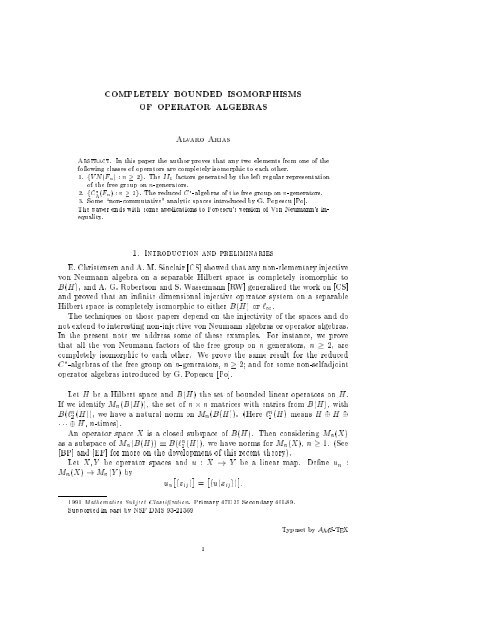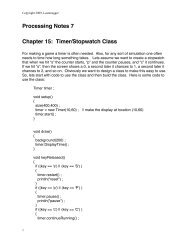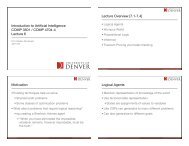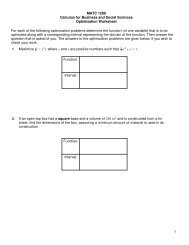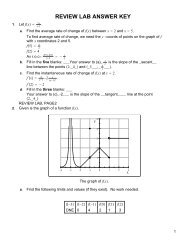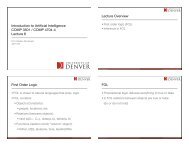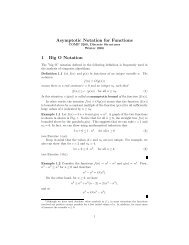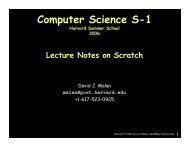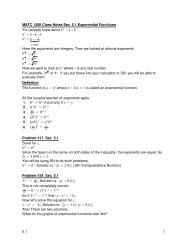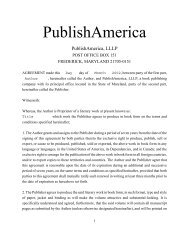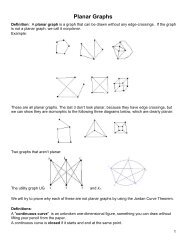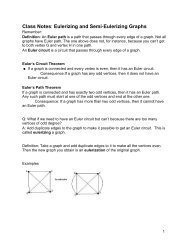Completely bounded isomorphisms of operator algebras
Completely bounded isomorphisms of operator algebras
Completely bounded isomorphisms of operator algebras
You also want an ePaper? Increase the reach of your titles
YUMPU automatically turns print PDFs into web optimized ePapers that Google loves.
4 ALVARO ARIASProposition 4. C (K) is 2-cb-complemented inC (F 1). Moreover, the orthogonalprojection onto `2(K) is completely <strong>bounded</strong> from C (F 1) onto C (K).We will present the pro<strong>of</strong> <strong>of</strong> Proposition 4 after the pro<strong>of</strong> <strong>of</strong> Theorem 2.Proposition 5. C (K) C (F 1) C (F 1) C (F 1). Moreover, the <strong>isomorphisms</strong>are completely <strong>bounded</strong>.S S S 1Pro<strong>of</strong>. Decompose K = K 1 K2 where K 1 =j=0 e 12jF ,andK 2 =j=0 e 2j+1F .It is clear that C (K 1) and C (K 2) are completely isometric to C (K). Moreover,Proposition 4 applied to K 1 and K 2 implies that they are cb-complemented inC (F 1)by the orthogonal projection. Therefore they are complemented in C (K)and we haveC (K) =C (K 1) C (K 2) C (K) C (K):Similarly, decompose K = K 3SK4 , where K 3 = e 1 F and K 4 = S 1j=2 e jF ,and apply the previous argument to conclude that C (K) C (F 1) C (K).Proposition 4 tells us that C (F 1)=C (K) Z for some Z. ThenC (F 1 ) C (K) Z C (K) C (K) Z C (K) C (F 1 ) C (K):Proposition 6. C (F k) C (F k) C (F k), for k =2 3 .Pro<strong>of</strong>. Divide the generators <strong>of</strong> F 1 into 1 k e 1 e 2 , and denote S by F 1the subgroup generated by the's F is isomorphic to F k . Let K =j=0 e jF .The pro<strong>of</strong> <strong>of</strong> Proposition 4 works and we get that C (K ) is 2-cb complementedin C (F 1) hence, by Proposition 1, it is 2-cb-complemented in C (F k) also. Itis clear that C (K ) C (K ) C (K ) and that C (K ) C (F k) C (K ).Hence the pro<strong>of</strong> <strong>of</strong> Proposition 5 applies and we get the result.We will present the pro<strong>of</strong> <strong>of</strong> Theorem 2 for completeness. This is a standardversion <strong>of</strong> Pe lczynski's decomposition method.Pro<strong>of</strong> <strong>of</strong> Theorem 2. Proposition 1 tells that C (F k) C (F 1) Y for someY , and that C (F 1) C (F k) Z, for some Z. Then Propositions 5 and 6 giveC (F k ) C (F 1 ) Y C (F 1 ) C (F 1 ) Y C (F 1 ) C (F k ):On the other handC (F 1 ) C (F k ) Z C (F k ) C (F k ) Z C (F k ) C (F 1 ):The rst step for the pro<strong>of</strong> <strong>of</strong> Proposition 4 is to understand how tonormtheelements in M n (C P P (K)). The typical element inL K looks like:ik e ip i , wherep i 2L i.e., p i =j a ije xj , for some x j 2 F .Whenwe consider <strong>operator</strong> spaces,we replace the scalars by matrices, so the canonical element <strong>of</strong>M n (C (K)) lookslike(1)Xik(I e i )A i for some A i 2 M n (L )
COMPLETELY BOUNDED ISOMORPHISMS OF OPERATOR ALGEBRAS 7We see that the rst term is the norm <strong>of</strong> T in M n ( C C (L ) ), and the second oneis the norm <strong>of</strong> T in M n (R R(F ) ). Here R(F )is`2(F ) with the row <strong>operator</strong>space structure.Using the notation <strong>of</strong> interpolation theory <strong>of</strong> <strong>operator</strong> spaces (see [P]) we concludeProposition 9. C (F 1) c:b: [ C C (F 1)] T [ R R(F 1 )]:Remark. If we are interested only in the Banach space structure, we have thatC (F 1) is isomorphic (but probably not completely isomorphic) to C C (F 1).3. Isomorphisms <strong>of</strong> non-commutative analytic <strong>algebras</strong>.In this section we will consider only the words consisting <strong>of</strong> positive powers <strong>of</strong>the generators <strong>of</strong> F k , and the identity. We denote this set by P k F k ,andlet`2(P k ) be the Hilbert space with orthonormal basis fe x : x 2 P k g. This Hilbertspace is also denoted by F 2 (H k ), the full Fock spaceonk-generators, see [Po]. LetP (or P k to avoid confusion) be the linear span <strong>of</strong> the basic elements, and considertwo norms on P: The kk 2 -norm, induced by `2(P k ), and the kk 1 -norm, denedaskpk 1 =supfkpqk 2 : q 2P k kqk 2 1g:Notice that p 2P k induces a left multiplication <strong>operator</strong> on `2(P k )andkpk 1 equalsthe <strong>operator</strong> norm <strong>of</strong> that map.Remark. If p 2P k ,thenthekpk 1 -norm does not coincide with the kpk-norm asan element <strong>of</strong> C (F k). In fact, if Q is the orthogonal projection onto `2(P k ) thenkpk 1 = kQpQk. We always have that kpk 1 kpk and sometimes the inequality isstrict (see Proposition 17).Let A (k) be the closure <strong>of</strong> P k in the norm topology <strong>of</strong> B(`2(P k )), and F 1 (k) theclosure in the strong <strong>operator</strong> topology. These spaces are studied in [Po], where hecalls them non-commutative analogues <strong>of</strong> the disk algebra and H 1 . When k =1they coincide with the classical denitions.The main results <strong>of</strong> this section are.Theorem 10. A (k) is completely isomorphic to A (1) when n =2 3 4 :Theorem 11. F 1 (k) is completely isomorphic to F 1 (1) when n =2 3 4 :As in the previous section we will only present the pro<strong>of</strong> <strong>of</strong> the rst one, the otherone is essentially the same. The pro<strong>of</strong> <strong>of</strong> Theorem 10 will follows from Propositions12, 13 and 14.Proposition 12. Let n m, and let :A (n) ! A (m) be the formal identity.Then is a complete isometry. Moreover, the orthogonal projection onto `2(P n ) iscompletely contractive from A (m) onto A (n).Pro<strong>of</strong>. Let E P m be the set <strong>of</strong> all y 2 P m whose rst letter does not start frome 1 e n . It is easy to see that fP n y : y 2 Eg forms a partition <strong>of</strong> P m . Then`2(P m )= P 1j=1 `2(P n y j ), where E = fy j : j 2 Ng.
8 ALVARO ARIASLet p 2P n and q 2P m , kqk 2 1. Use the previous partition to decompose q asq = P j r je yj , for some r j 2P n and y j 2 E. Then1X1Xkpqk 2 = 2kpr i k 2 = 2i=0 p r i 2kri=0 i k 2 2kr i k 2 sup2 pi r i 2kr i k 22kpk 2 1 :This tells us that kpkA(n) = kpkA(m). Moreover, if p 2 A (n) A (m), we normitwith elements from P n .This is the fact that we use for the complementation. Given p 2P m , write it asp = p 1 + p 2 ,wherep 1 2P n and p 2 2 (P n ) ? .Thenifq 2P n ,wehave that p 1 q 2P nand p 2 q 2 (P n ) ? . Hence,kp 1 k 1 = supq2P nkqk 2The completely <strong>bounded</strong> part is very similar.kp 1 qk 2 supq2P nkqk 2kpqk 2 kpk 1 :Proposition 13. There exists a subspace <strong>of</strong>A (2) completely isometric to A (1)and completely complemented by the orthogonal projection.Pro<strong>of</strong>. Let a b be the generators <strong>of</strong> P 2 .Let P be the set <strong>of</strong> all words generatedby ab a 2 b a 3 b a 4 b . P is clearly isomorphic to P 1 . Let E P 2 be the set<strong>of</strong> all words in P 2 such that no initial segment belongs to P . Thenitiseasytosee that fP y : y 2 Eg forms a partition <strong>of</strong> P 2 , and the pro<strong>of</strong> is like that<strong>of</strong>theprevious proposition.Proposition 14. A (1) is completely isomorphic to C A (1), where C is thecolumn Hilbert space.Pro<strong>of</strong>. Divide the generators <strong>of</strong> P 1 into S 1 2 e 1 e 2 , and let P be the1set <strong>of</strong> words generated by the's. Let K = e j=1 jP P 1 , and let P(K) bethespan <strong>of</strong> the basic elements in K. Denote the closure <strong>of</strong> P(K) inthe`2-norm by`2(K), and in the kk 1 -norm by A (K).P The canonical element<strong>of</strong>P(K) looks likeik e ip i , for some k 2 N and p 2P .Given any q 2P the e i p i q's are orthogonal. Then we have, 1 X 1e i p i =iksupkqk 21 X ike i p i q2= supkqk 21s Xikkp i qk 2 2 = XSince A (P ) is isometric to A (1) we conclude that A (K) is isometric to C A (1).Moreover, the elements in A (k) are normed by elements in `2(P ).We willnow see that A (K) is complemented in A (1). Let p 2P 1 and decomposeit as p = p 1 + p 2 , where p 1 2P(K) and p 2 2 (P(K)) ? . If q 2P ,thenp 1 q 2P(K) and p 2 q 2 (P(K)) ? . Hence, kp 1 qk 2 kpqk 2 ,andkp 1 k 1 kpk 1 .As in the pro<strong>of</strong> <strong>of</strong> Proposition 5 it is clear that A (K) is isomorphic to its square,and then isomorphic to A (1).The completely <strong>bounded</strong> part follows in the same way after we replace the scalarsby matrices.ikp i p i2:1
COMPLETELY BOUNDED ISOMORPHISMS OF OPERATOR ALGEBRAS 9Pro<strong>of</strong> <strong>of</strong> Theorem 10. By Proposition 12 and 13 we have thatA (k) =A (1) Yfor some Y . Since A (1) A (1) A (1), we haveA (k) =A (1) Y A (1) A (1) Y A (1) A (k):On the other hand, A (1) =A (k) Z, forsomeZ. If Q : A (1) ! A (k) isthatprojection and I : C ! C is the identity onC, I Q decomposes C A (1) =[C A (k)] [C Z] because Q is completely <strong>bounded</strong>. Hence,A (1) C A (1)=[C A (k)] [C Z] A (k) [C A (k)] [C Z] A (k) [C A (1)] A (k) A (1):4. Applications to Von Neumann's inequalityFix k for this section and let P k be the positive words generated by e 1 e k .As in the previous section, F 2 (H k )= `2(P k ) is the full Fock space on H k ,a k-dimensional Hilbert space A (k) andF 1 (k) have the same meaning.In [Po] G. Popescu proved that if T 1 T k 2 B(`2) are suchthatk P ik T iT i k1 (i.e., k[T 1 T k ]k1) then any p(e 1 e k ) 2 A (k) satises(4) kp(T 1 T k )kkpkA(k) :When k = 1, this is the classical Von Neumann's inequality.In this section we prove that A (k) andF 1 (k) contain many complementedHilbertian subspaces. Hence we can easily compute kpkA(k) whenever p belongsto one <strong>of</strong> those subspaces, and use kpkA(k) in Popescu's inequality (4). (See [AP]for more examples and connections with inner functions).We start with the following elementary lemma.Lemma 15. Let p = P i a ie xi q = P j b je yj 2Pbe such that x i y j = x i 0y j 0 ifand only if x i = x i 0 and y j = y j 0, (that is, we cannot have any cancellation), thenkpqk 2 = kpk 2 kqk 2 .P PPro<strong>of</strong>. We have that pq =i j a ib j e xiy j. Since all the x i y j -terms are dierent,the e xiy j's are orthogonal. Hence,kpqk 2 =s XiXjja i b j j 2 =s Xija i j 2 s Xjjb j j 2 = kpk 2 kqk 2 :Remark. The lemma P P extends to the M n -case just as easily. If T =i A i e xi 2 M n (P) and q =j b j e yj 2 `n2(P), P Pthen Tq =i j A ib j e xiy jandqP PkTqk 2 =i j kA ib j k 2.2
10 ALVARO ARIASProposition 16. Let W n P k be the set <strong>of</strong> all words in P k having n-letters,and let X n = spanfe x : x 2 W n gA (k). Then X n is completely isometric toC n k, the column Hilbert space <strong>of</strong> the same dimension. Moreover, X n is completelycomplemented inA (k).Pro<strong>of</strong>. Let P p 2 X n and q 2P k , kqk 2 1. Since F P 2 1(H k )=m=0 X m,wewriteq as q =m r m, where r m 2 X m . Notice that pr m 2 X n+m and hence all <strong>of</strong> themare orthogonal. Moreover, if x 1 x 2 2 X n , y 1 y 2 2 X m and x 1 y 1 = x 2 y 2 ,thenitisnecessary that x 1 = x 2 and y 1 = y 2 . This implies that there is no cancellation inpr m and hence, by the previous lemma, kpr m k 2 = kpk 2 kr m k 2 . Therefore,vu vutX uut 1 1Xkpr m k 2 = 2kpqk 2 =m=0m=0kpk 2 2 kr mk 2 2 = kpk 2kqk 2 and kpk 1 = kpk 2 .The completely P <strong>bounded</strong> case is very similar. A canonical element <strong>of</strong>M n0(X n )looks like T =ik A i e xi , where A i 2 M n0and e xi 2 X n . A canonical element<strong>of</strong> `n02 (X P P m) looks like q =j b j e yj , where b j 2 `n02and e yj 2 X m . ThenTq =iPj A ib j e xi e yj 2 `n02 (X n+m) and all <strong>of</strong> those terms are orthogonal toeach other. Then the pro<strong>of</strong> proceeds as those <strong>of</strong> section 2. The complementationpart is very easy: If p 2 X n ,thenkpk 1 = kpe 0 k 2 .Multiplication from the left byany one <strong>of</strong> the e i 's in A (k) orF 1 (k) is an isometry(i.e., kpk 1 = ke i pk 1 ). However, multiplication from the right doesnothave tobelike that.Proposition 17. Let p 2 A (k ; 1) A (k). Then kpe k k 1 = kpe k k 2 = kpk 2 .P P Pro<strong>of</strong>. Let p 2P k;1 , p =i a ie xi where x i 2 P k;1 ,andq 2P k , q =j b je yjwhere y j 2 P k .Thenpe k q = X iXja i b j e xi e k e yj :Since e xi e k e yj = e xi 0 e k e yj 0 i x i = x i 0 and y j = y j 0, then Lemma 15 applies andwe have that kpe k qk 2 = kpk 2 ke k qk 2 = kpk 2 kqk 2 .We conclude with the following two applications <strong>of</strong> the previous propositions.1. Let p(e 1 e 2 e k ) 2Pbe a non-commutative homogeneous polynomial <strong>of</strong>degree n i.e., p(e 1 P e k )= n p(e 1 e k ), (or p 2 X n with the notation <strong>of</strong>Proposition 16). If kik T iT i k1, thenkp(T 1 T 2 T k )kkpk 2 :2. Let T 1 T 2 2 B(`2) besuch that k[T 1 T 2 ]k1 (i.e., kT 1 T 1 + T 2T 2k1) andlet p(t) be a polynomial in one variable. The classical Von Neumann's inequalitystates that kp(T 1 )kkpk 1 . Therefore, using the Banach algebra properties <strong>of</strong>B(`2) we get thatkp(T 1 )T 2 ksupt2T jp(t)j
COMPLETELY BOUNDED ISOMORPHISMS OF OPERATOR ALGEBRAS 11but if we apply Proposition 17 to Popescu's inequality wegetkp(T 1 )T 2 ks ZT jp(t)j2 dm(t):Acknowledgment. The author thanks Gelu Popescu for useful discussions.References[AP] A. Arias and G. Popescu, Factorization and reexivity on Fock spaces, preprint.[BP] D. Blecher and V. Paulsen, Tensor products <strong>of</strong> <strong>operator</strong> spaces, J.Funct. Anal. 99 (1991),262{292.[CS] E. Christensen and A. M. Sinclair, <strong>Completely</strong> <strong>bounded</strong> <strong>isomorphisms</strong> <strong>of</strong> injective von Neumann<strong>algebras</strong>, Proceedings <strong>of</strong> the Edinburgh Math. Soc. 32 (1989), 317{327.[E]E. Eros, Advances in quantized functional analysis, Proceedings <strong>of</strong> the International Congress<strong>of</strong> Math., Berkeley (1986), 906{916.[ER] E. Eros and Z. J. Ruan, A new approach to <strong>operator</strong> spaces, Canadian Math. Bull. 34(1991), 329{337.[FP] A. Figa-Talamanca and M. Picardello, Harmonic analysis <strong>of</strong> free groups, lecture notes inpure and applied mathematics, vol. 87, Marcel Dekker, 1983.[HP] U. Haagerup and G. Pisier, Bounded linear <strong>operator</strong>s between C -<strong>algebras</strong>, Duke Math. 71(3) (1993), 889{925.[PV] M. Pimsner and D. Voiculescu, K-groups <strong>of</strong> reduced crossed products by free groups, J.Operator Theory 8 (1982), 131{156.[P]G. Pisier, The <strong>operator</strong> Hilbert space OH, complex interpolation and tensor norms (toappear).[Po] G. Popescu, Von Neumann inequality for (B(H) n ) 1 , Math. Scand. 68 (1991), 292{304..[RW] A. G. Robertson and S. Wassermann, <strong>Completely</strong> <strong>bounded</strong> <strong>isomorphisms</strong> <strong>of</strong> injective <strong>operator</strong>systems, Bull. London Math. Soc. 21 (1989), 285{290.[S] S. Sakai, C -<strong>algebras</strong> and W -<strong>algebras</strong>, Springer-Verlag (1971).Division <strong>of</strong> Mathematics, Computer Science and Statistics, The University <strong>of</strong>Texas at San Antonio, San Antonio, TX 78249, U.S.A.E-mail address: arias@ringer.cs.utsa.edu


